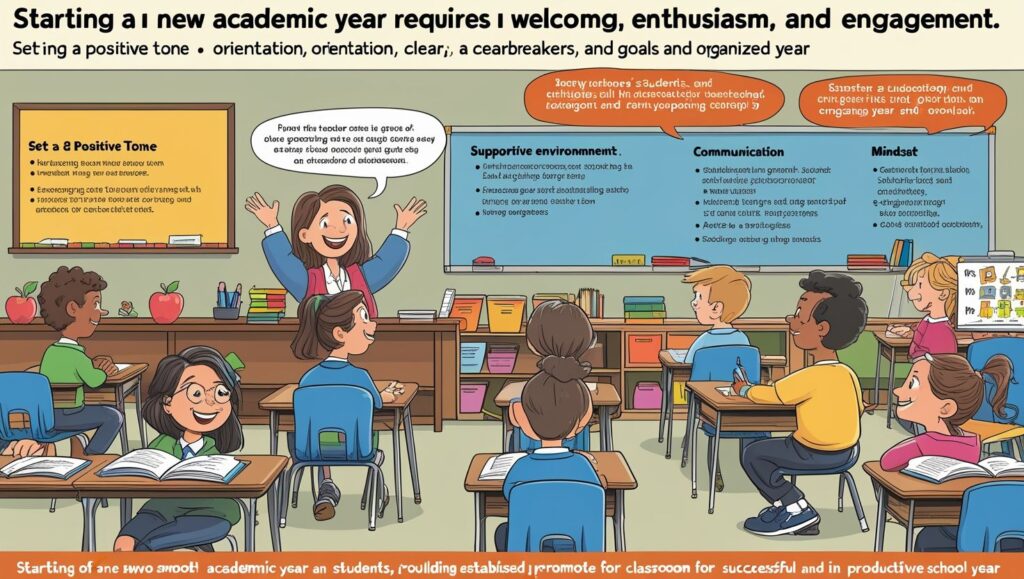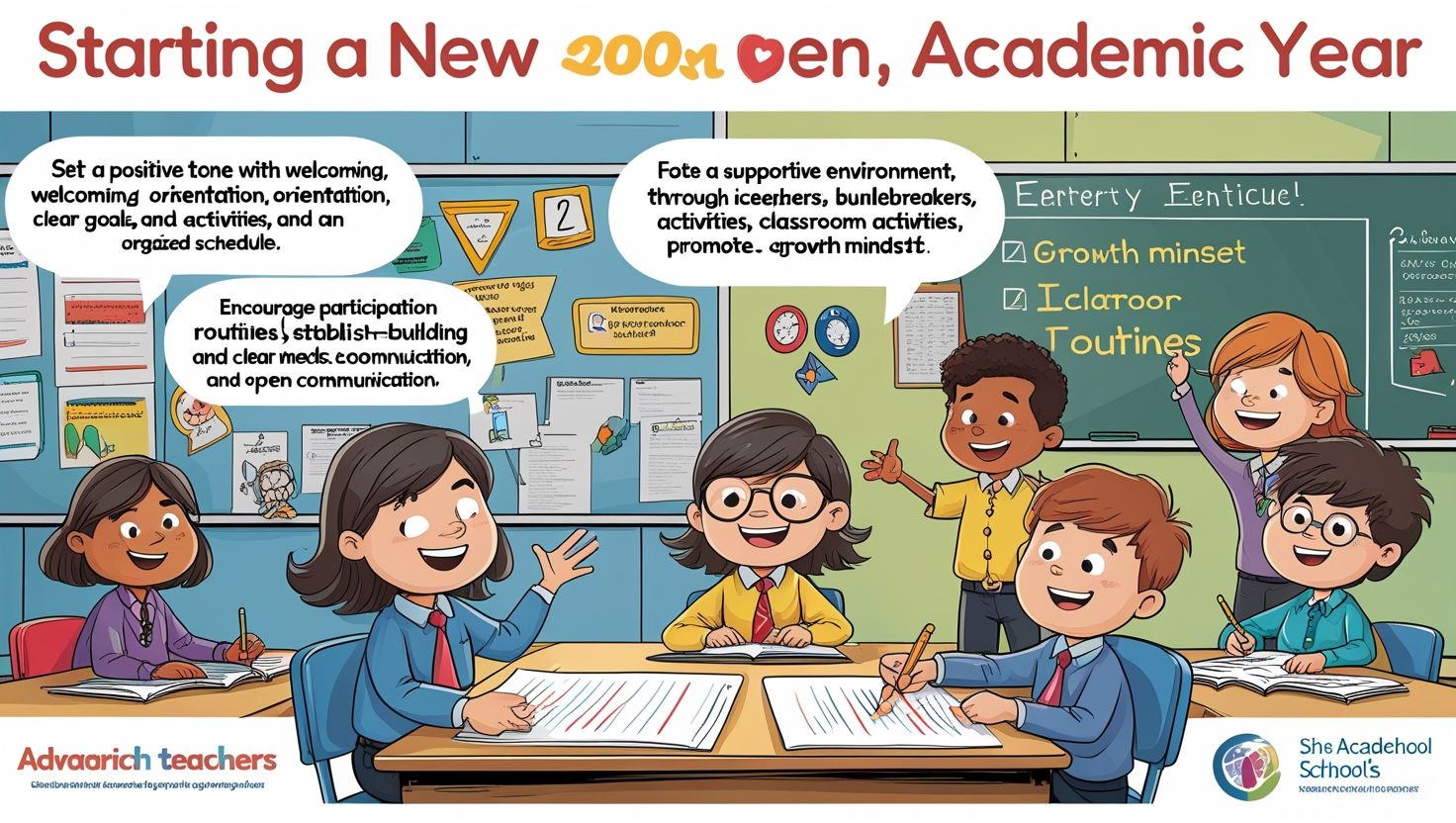How to Start a New Academic Year in a School, The beginning of a new academic year is a time of excitement, anticipation, and opportunity for students, teachers, and school administrators. It marks a fresh start, a chance to set new goals, and an opportunity to create a positive and productive learning environment. However, starting the academic year on the right foot requires careful planning, collaboration, and a proactive approach. This article provides a detailed guide on how schools can effectively launch a new academic year, ensuring a smooth transition and setting the stage for success.
1. Preparing the School Environment
The physical environment of a school plays a significant role in shaping the learning experience. Before the academic year begins, it’s essential to ensure that classrooms, hallways, and common areas are clean, organized, and welcoming. Teachers and staff should collaborate to set up classrooms with engaging displays, updated learning materials, and comfortable seating arrangements. A well-organized classroom not only enhances the learning experience but also helps students feel more focused and motivated.
For administrators, conducting a thorough inspection of the school’s infrastructure is crucial. This includes checking lighting, ventilation, safety measures, and the functionality of equipment like computers, projectors, and interactive whiteboards. A safe and well-maintained environment fosters a sense of security and allows students to concentrate on their studies. Additionally, incorporating elements of nature, such as plants or natural light, can create a calming and inspiring atmosphere.
2. Setting Clear Goals and Expectations
The start of a new academic year is the perfect time to set clear goals and expectations for students, teachers, and staff. Administrators should communicate the school’s mission, vision, and academic priorities to all stakeholders. This helps create a shared sense of purpose and direction. Teachers, on the other hand, can outline classroom rules, grading policies, and behavioral expectations during the first week of school. Clear guidelines help students understand what is expected of them and create a structured and predictable environment.
Encouraging students to set personal academic and extracurricular goals is equally important. Goal-setting provides students with a sense of direction and purpose, motivating them to work towards their objectives. Teachers can guide students in creating actionable plans and regularly monitor their progress. By fostering a culture of accountability and growth, schools can inspire students to achieve their full potential.

3. Building Relationships and Fostering Inclusion
A strong sense of community is essential for a successful academic year. Teachers and administrators should prioritize building positive relationships with students and their families from the very beginning. Icebreaker activities, team-building exercises, and open-house events can help students feel comfortable and connected to their peers and teachers. For new students, orientation programs can ease the transition and help them acclimate to the school environment.
Inclusion is another critical aspect of fostering a supportive school culture. Ensure that all students, regardless of their background or abilities, feel valued and respected. Teachers can incorporate diverse perspectives into their lessons and create opportunities for students to share their experiences. By promoting empathy and understanding, schools can cultivate an inclusive environment where every student thrives.
4. Professional Development for Teachers
The start of a new academic year is an excellent time for teachers to engage in professional development opportunities. Workshops, seminars, and training sessions can help educators stay updated on the latest teaching strategies, technologies, and curriculum standards. Collaborative planning sessions with colleagues can also provide valuable insights and ideas for enhancing classroom instruction.
Administrators should encourage teachers to set personal and professional goals for the year, such as improving student engagement or integrating more technology into their lessons. By investing in their growth, teachers can bring fresh perspectives and innovative approaches to their classrooms, ultimately benefiting their students. Additionally, creating a culture of continuous learning among staff fosters collaboration and a shared commitment to excellence.
5. Engaging Parents and Guardians
Parental involvement is a key factor in a student’s academic success. Schools should make a concerted effort to engage parents and guardians from the outset. Hosting a back-to-school night or parent-teacher orientation can help families understand the school’s expectations and how they can support their child’s learning at home. Providing regular updates through newsletters, emails, or a school app can also keep parents informed about upcoming events, academic progress, and school policies.
Encouraging open communication between teachers and parents fosters a collaborative partnership that benefits students. When parents are actively involved in their child’s education, students are more likely to feel supported and motivated to succeed. Schools can also create opportunities for parents to volunteer or participate in school activities, further strengthening the school-home connection.
6. Implementing Effective Time Management Strategies
Time management is crucial for both students and teachers as they navigate the demands of a new academic year. Teachers should create a well-structured syllabus that outlines the curriculum, assignments, and assessment schedules. This helps students manage their time effectively and stay on track throughout the year. For younger students, visual schedules and reminders can be particularly helpful in developing time management skills.
Administrators can support time management by ensuring that the school calendar is organized and communicated clearly to all stakeholders. Avoiding scheduling conflicts and providing ample notice for important events can help everyone plan ahead and reduce stress. Additionally, teaching students strategies for prioritizing tasks and managing deadlines can empower them to take ownership of their learning.
7. Emphasizing Mental Health and Well-Being
The start of a new academic year can be both exciting and overwhelming for students and staff. Schools should prioritize mental health and well-being by creating a supportive environment where everyone feels comfortable seeking help when needed. Implementing mindfulness practices, offering counseling services, and promoting a healthy work-life balance can contribute to a positive school culture.
Teachers can incorporate social-emotional learning (SEL) activities into their lessons to help students develop skills like self-awareness, empathy, and resilience. By addressing mental health proactively, schools can create a nurturing environment that supports academic and personal growth. Additionally, providing resources and training for teachers on recognizing and addressing mental health concerns ensures that students receive the support they need.
8. Evaluating and Reflecting on Progress
As the academic year progresses, it’s important to regularly evaluate and reflect on the effectiveness of strategies and initiatives. Teachers can use formative assessments to gauge student understanding and adjust their teaching methods accordingly. Administrators should gather feedback from teachers, students, and parents to identify areas for improvement and celebrate successes.
Reflection is a powerful tool for continuous improvement. Encourage students to reflect on their learning experiences and set new goals as they grow. By fostering a culture of reflection and growth, schools can ensure that the academic year remains dynamic and responsive to the needs of the community. Regular check-ins and progress reviews help maintain momentum and keep everyone aligned with the school’s objectives.
9. Incorporating Technology and Innovation
In today’s digital age, integrating technology into the classroom is essential for preparing students for the future. Schools should ensure that teachers are equipped with the necessary tools and training to use technology effectively. This includes using learning management systems (LMS), interactive software, and online resources to enhance instruction and engagement.
Innovative teaching methods, such as project-based learning, flipped classrooms, and gamification, can make learning more interactive and enjoyable. Encouraging students to use technology responsibly and creatively fosters critical thinking and problem-solving skills. By embracing innovation, schools can create a dynamic and forward-thinking learning environment.
10. Celebrating Achievements and Milestones
Recognizing and celebrating achievements, both big and small, is an important part of building a positive school culture. Whether it’s academic success, extracurricular accomplishments, or personal growth, acknowledging students’ efforts boosts their confidence and motivation. Schools can organize award ceremonies, showcase student work, or create a “wall of fame” to highlight achievements.
Celebrating milestones, such as the completion of a challenging project or the end of a term, helps students feel a sense of accomplishment and pride. It also reinforces the value of hard work and perseverance. By creating a culture of celebration, schools can inspire students to strive for excellence and take pride in their accomplishments.
Conclusion
Starting a new academic year is an opportunity to set the stage for success and growth. By preparing the school environment, setting clear goals, building relationships, and prioritizing well-being, schools can create a positive and inclusive atmosphere where students and staff thrive. Engaging parents, investing in professional development, and emphasizing time management further contribute to a productive and fulfilling year. Ultimately, a well-planned and thoughtful approach to the start of the academic year lays the foundation for a rewarding educational journey for all. With careful preparation and a focus on collaboration, schools can ensure a successful and impactful academic year.

2 thoughts on “How to Start a New Academic Year in a School”
Comments are closed.